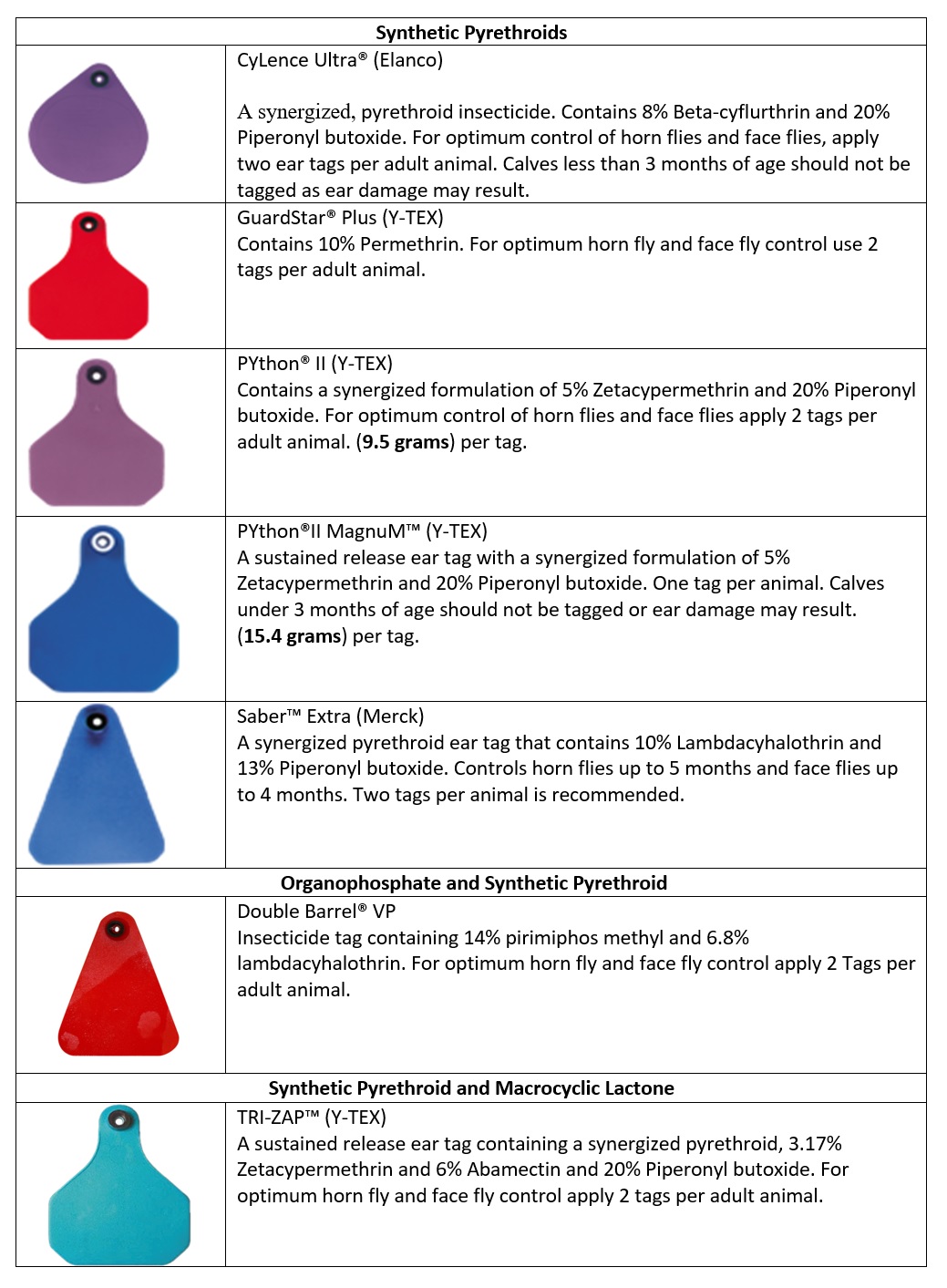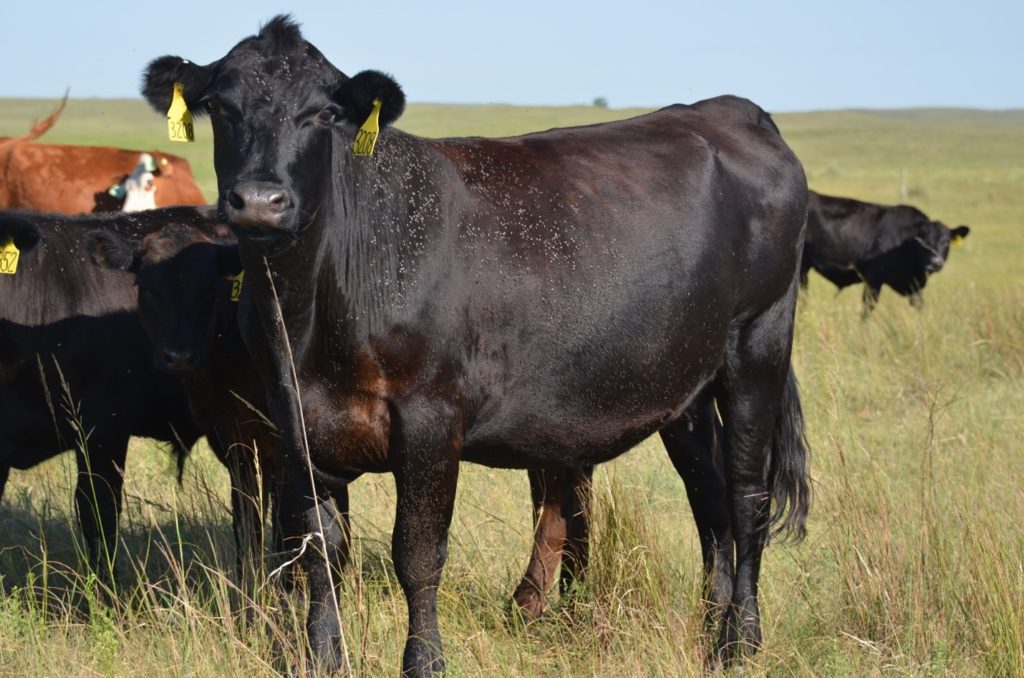As temperatures warm, pasture fly season is just around the corner. The horn fly, has been and continues to be a major fly pest of pasture and rangeland cattle across the U. S. During a warm spring in Nebraska, horn flies can be seen on cattle as early as the third week of April. Historically, horn flies appearing during this period may perish from cold fronts arriving later in the month, or in early May. Even with challenging weather conditions, the horn fly can adapt to these conditions by shortening the number of days to complete its life cycle.
Horn fly control measures may need to be implemented earlier this year if the weather stays warm and dry. Horn fly numbers could increase beyond the 200-fly Economic Injury Level (EIL) before the end of May. Once horn fly numbers reach the EIL, cattle will change their grazing patterns and behavior, reducing milk production and weight gain, economically affecting production. Studies conducted in Nebraska and elsewhere have shown calf weaning weights can be reduced by 12 to 20 lbs. when the mother cow receives no horn fly control. Horn flies can impact stocker and replacement heifers weight gain up to 18%. Horn flies can also spread summer mastitis.
In Nebraska, horn flies produce multiple generations through the fly season, reaching well over two thousand flies on untreated cattle in late August or early September (Figure 1). Control levels may need to be adjusted or control methods changed to address late season horn fly numbers.

Monitoring horn fly numbers on your cattle helps determine proper fly control management. Observe cattle weekly during the fly season, maybe when checking salt or mineral. Observe between the hours of 8:00 AM to 11:30 AM when horn flies are normally found on the shoulders, topline and sides of the animals. Afternoon observations can be less exact because horn flies will have moved to the belly area, making it more difficult to count fly numbers.
Control Methods
Dust bags hold insecticide dust that filters through the bottom of the bag when cattle contact the bag while passing under it. The best horn fly control is achieved when cattle are forced to pass under the bag(s) on their way to water, mineral, or salt. This can be accomplished by fencing the water tank and suspending dust bags in the entrance-exit gate. Forced-use dust bags may not be practical if cattle can obtain water from ponds or streams. In this case, place dust bags to be used free choice at locations where cattle loaf during the day. Dust bags in forced use arrangements can reduce horn fly numbers by 80-90%. Studies have shown horn fly control is 25-50% less effective when using a free choice dust bags arrangement. Products labeled for use are two organophosphates, Rabon and Co-Ral, and synthetic pyrethroid formulations containing permethrin.
Backrubbers and oilers allow cattle to satisfy their scratching instinct. These devices can be made from burlap wrapped chain or wire suspended between two posts and a large variety of backrubbers and oilers are commercially available. Backrubbers and oilers will need to be recharged periodically during the fly season and the insecticide should be diluted with an approved backrubber oil, listed on the insecticide label. Backrubbers and oilers like dust bags, work best in a forced use arrangement. Control products labeled for backrubbers are Co-Ral, Prolate, Ravap, and Permethrin. Ravap is a Restricted Use Pesticide, so an applicator must be a Certified Pesticide Applicator to purchase and apply this product.
Animal sprays come as ready-to-use or are diluted with water before applying. It is important to get complete coverage of each animal with the spray. Animals can be treated in small groups to assure complete coverage. Spray applications can be delivered using a low-pressure sprayer or a mist blower sprayer. Spray applications will provide from 7 to 14 days of control and will need to be re-applied throughout the fly season. Products available are Co-Ral, Prolate, Permethrin (many brands), Pyrethrins, Ravap, and Vapona. Both Ravap and Vapona are Restricted Use Pesticides, so an applicator must be a Certified Pesticide Applicator to purchase and apply these products.
Pour-ons are ready-to-use formulations applied in measured doses to animals based on body weight. Most function as contact insecticides, causing insect mortality when the chemical is absorbed into the insect by direct contact. However, pour-on products that contain macrocyclic lactones (endectocides) are systemic. Endectocides and permethrin + dimilin products should not be applied in the late spring and throughout the fly season since they may impact other pests and beneficial insects such as dung beetles, who use dung as a source of food and for reproduction. Typically, pour-ons provide 7 to 21 days of horn fly control, so they must be re-applied periodically. Products available are permethrin (many brands), permethrin + dimilin, and endectocides and their generics.
Feed-throughs and Insect Growth Regulators (IGRs) are insecticides that are incorporated into mineral blocks, tubs, or loose mineral. The insecticide is passed out in the manure and kills fly larvae that develop in the manure. For maximum effectiveness, these products should be offered to cattle early in the fly season before fly numbers increase and require steady consumption. Be aware that horn fly migration from neighboring herds can mask the effectiveness of feed-throughs/IGRs. Products available are Altosid (Methoprene), ClariFly, and Rabon. If face fly control is also desired, use either ClariFly or Rabon; Altosid has no activity against developing face fly larvae.
Insecticide ear tags are controlled-release, sustained release, or slow-release devices. One or more insecticides are formulated into a polymer matrix in the ear tag that is slowly released from the matrix and is deposited on the hair coat as the animal moves or grooms itself. In Nebraska, apply ear tags the last week of May or the first week of June to achieve maximum control through the fly season. Ear tags applied too early may decline in efficacy while fly numbers are still high, impacting production. Follow label recommendations on the number of tags per animal. My studies show applying two tags per adult animal will reduce horn fly numbers best. Tagging only the calf and not the mother cow does not provide enough horn fly control. A list of available insecticide ear tags for 2022 are in Table 1 (at the end of the article). Please note: As of February 28, 2022, the Warrior Insecticide ear tag can no longer be used based on ruling by the Environmental Protection Agency. If you have carryover tags from last year, please do not use them this year.
Compressed air application applies an individual capsule of insecticide to an animal using a device such as a paint ball gun and can offer horn fly control between 21 and 35 days. AiM VetCaps are available in a synthetic pyrethroid, or abamectin formulation.
Traps physically capture horn flies. The Bruce fly trap (Figure 2) is a walk-through system where cattle enter through either end, pass through a 10-foot trap area, and contact a series of strips made of canvas or old carpet. These strips dislodge most of the horn flies on the animals’ topline and sides. Since horn flies are attracted to light, disturbed flies move to the top of the trap where they are captured. The animal exits the trap with fewer flies on it, and the trapped flies cannot escape. Repeated use of the trap can reduce the overall local horn fly population. Like dust bags and oilers, the Bruce trap is best employed in a force-use situation where cattle must pass through it on a regular basis. Field studies conducted in Missouri during the 1980s showed the trap reduced horn flies about 50%. For more information or to get plans to build a Bruce fly trap, please contact me at dboxler1@unl.edu or 308-696-6721.



Source:
Dave Boxler, Nebraska Extension Educator
Photo credit: Dave Boxler.








